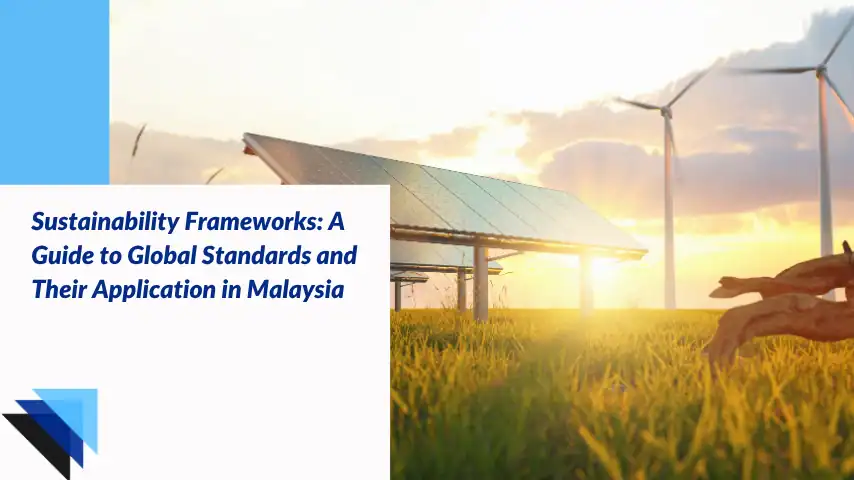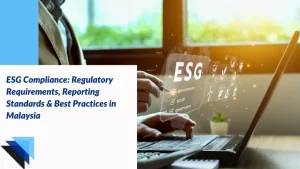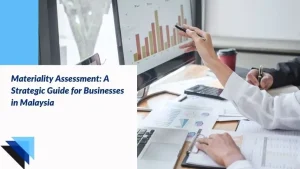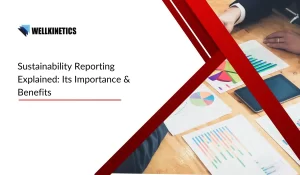Sustainability frameworks are structured approaches that provide organizations with guidelines and standards to integrate sustainability into their strategies, operations, and reporting mechanisms. These frameworks are designed to help businesses assess their environmental, social, and governance (ESG) performance in a systematic manner. By defining clear principles and metrics, sustainability frameworks enable organizations to identify key areas for improvement, set measurable goals, and enhance transparency in their sustainability efforts.
In today’s rapidly evolving business landscape, understanding and implementing these frameworks isn’t just good practice; it’s becoming essential for long-term success, especially in Malaysia’s growing economy.
Are you struggling to navigate the complex landscape of sustainability standards? Whether you’re a business leader, sustainability professional, or someone interested in corporate responsibility, this comprehensive guide will walk you through:
- Global frameworks like GRI, SDGs, CDP, SASB, SBTi, and IFRS that shape sustainable business practices
- How these standards specifically apply to Malaysian organizations
- Key implementation strategies and challenges to consider
- Ways to align your business with international sustainability requirements
Let’s explore how these frameworks can transform your organization’s approach to sustainability and ESG excellence.
Struggling to Align with Global Sustainability Standards?
We simplify integrating international frameworks into your operations, making ESG compliance hassle-free for your business.
- What Are Global Sustainability Standards and Why Are They Important?
- What Are the Key International Reporting Frameworks for Sustainability?
- What Are ESG Performance Metrics and Standards?
- How Are Global Sustainability Standards Implemented in Malaysia's Business Context?
- What Are the Business Benefits of Adopting Sustainability Frameworks?
- What Are the Common Challenges in Implementing Sustainability Frameworks and How Can They Be Overcome?
- How Wellkinetics Can Help
What Are Global Sustainability Standards and Why Are They Important?
Global sustainability standards refer to recognized guidelines and norms established by various organizations and initiatives to promote responsible environmental, social, and governance (ESG) practices. These standards provide a framework for organizations to measure, report, and improve their sustainability performance across multiple dimensions. By adhering to these established protocols, organizations can demonstrate their commitment to sustainable development, enhance transparency, and build trust with stakeholders, including customers, investors, and regulators.
How Has Sustainability Reporting Evolved Over Time?
The journey of sustainability reporting has transformed significantly over the past few decades, marking a pivotal shift in how businesses approach environmental and social responsibility. The sustainability framework concept emerged in the 1990s when organizations recognized the need for structured approaches to measure and report their impact beyond financial metrics.
Initially, various framework options were fragmented, with different regions and industries developing their own standards. The most important framework developments occurred in the late 1990s with the introduction of the Global Reporting Initiative (GRI), which set the foundation for modern sustainability reporting practices.
The evolution of ESG framework standards has been driven by increasing stakeholder demands for transparency and accountability. As global awareness of environmental and social issues grew, businesses faced mounting pressure to adopt comprehensive reporting mechanisms. This led to the development of more sophisticated and standardized approaches to sustainability reporting.
Today’s landscape features multiple integrated reporting systems, where each sustainability framework serves specific purposes while complementing others. Organizations often implement various framework combinations to meet different stakeholder needs and regulatory requirements. The convergence of these standards has created a more cohesive approach to sustainability reporting, enabling businesses to better track and communicate their ESG performance.
The rapid advancement of technology and data analytics has further enhanced the capabilities of modern sustainability reporting. These tools have made it easier for organizations to collect, analyze, and report sustainability metrics across their operations, leading to more accurate and comprehensive ESG framework implementation.
What Are the Key International Reporting Frameworks for Sustainability?
Key international reporting frameworks are established standards and guidelines designed to assist organizations in measuring, reporting, and enhancing their sustainability efforts. These frameworks provide a structured approach to environmental, social, and governance (ESG) performance that allows companies to communicate their impacts transparently and consistently. Below are some of the most widely recognized frameworks that guide organizations in their sustainability endeavors:
1. Global Reporting Initiative (GRI)
The Global Reporting Initiative stands as the pioneer in sustainability reporting frameworks, setting the gold standard since 1997. The GRI standard provides organizations with a comprehensive methodology for reporting their economic, environmental, and social impacts. This framework emphasizes transparency and stakeholder engagement, making it the most widely adopted reporting system globally.
Organizations using the GRI standard benefit from its structured approach to sustainability disclosure. The framework’s modular nature allows companies to focus on material topics relevant to their operations while maintaining comparability across sectors. With regular updates and stakeholder input, the GRI ensures its standards remain current and effective.
2. UN Sustainable Development Goals (SDGs)
The UN sustainable development goals represent a universal call to action, comprising 17 interconnected objectives designed to achieve a more sustainable future by 2030. These goals address global challenges ranging from poverty and inequality to climate change and environmental degradation. Organizations worldwide integrate these goals into their sustainability strategies, creating measurable targets aligned with global priorities.
Leading companies demonstrate how SDG integration drives both sustainability performance and business success. The framework provides a common language for organizations to communicate their contributions to global sustainable development, while also helping them identify opportunities for innovation and growth.
3. Carbon Disclosure Project (CDP)
The carbon disclosure project has emerged as the leading platform for environmental reporting, focusing specifically on climate change, water security, and deforestation risks. This framework enables organizations to measure, manage, and disclose their environmental impacts through standardized questionnaires and assessment methodologies.
The CDP’s influence extends beyond mere reporting, as it helps companies identify risks and opportunities related to climate change. By providing detailed insights into environmental performance, the framework supports informed decision-making and promotes accountability in environmental stewardship. Organizations participating in CDP reporting gain credibility with investors and stakeholders while contributing to global climate action efforts.
4. Sustainability Accounting Standards Board (SASB)
The Sustainability Accounting Standards Board (SASB) focuses on the financial materiality of sustainability issues, providing industry-specific standards that guide companies in disclosing relevant ESG information to investors. Since its establishment, SASB has developed a set of standards tailored to 77 industries, ensuring that organizations communicate the most pertinent sustainability factors that could impact financial performance.
By aligning with SASB standards, businesses can present ESG data in a way that resonates with investors and stakeholders concerned about long-term value creation. This framework emphasizes the importance of integrating sustainability into overall business strategy, helping organizations identify and mitigate risks while capitalizing on opportunities for sustainable growth.
ALSO READ: Materiality Assessment: A Strategic Guide for Businesses in Malaysia
5. Science Based Targets initiative (SBTi)
The Science Based Targets Initiative (SBTi) is a collaborative effort that encourages companies to set greenhouse gas (GHG) emissions reduction targets based on the latest climate science. It provides a clear framework for organizations to align their emissions targets with the global aim of limiting temperature rise to well below 2 degrees Celsius in line with the Paris Agreement, with a strong emphasis on pursuing the preferred 1.5°C target as recommended by the Intergovernmental Panel on Climate Change (IPCC).
By committing to SBTi targets, organizations can demonstrate their dedication to combating climate change and showcase credible, science-backed reductions in emissions. The initiative offers guidance for setting ambitious targets, ensuring that companies contribute meaningfully to international climate goals. Participating organizations not only enhance their reputation among consumers and investors but also foster innovation in low-carbon technologies and processes that can lead to long-term operational efficiencies and cost savings.
6. IFRS Sustainability Disclosure Standards
The International Financial Reporting Standards (IFRS) Sustainability Disclosure Standards, developed by the International Sustainability Standards Board (ISSB) under the IFRS Foundation, provide a framework for organizations to disclose sustainability-related financial information in a way that is relevant and comparable across industries. Developed to support the growing demand for transparency in corporate sustainability practices, these standards outline requirements for companies to report on how sustainability issues affect their financial performance and vice versa.
Key Components:
- IFRS S1 sets out general requirements for disclosing sustainability-related risks and opportunities that may affect a company’s cash flows, financing access, or cost of capital
- IFRS S2 focuses on climate-related disclosures and aligns with widely recognised frameworks like the TCFD
By adhering to IFRS Sustainability Disclosure Standards, businesses can enhance the credibility and utility of their sustainability reporting. This framework encourages a systematic approach to identifying, evaluating, and reporting on key sustainability risks and opportunities that could influence an organization’s long-term financial success. Through the integration of sustainability disclosures into financial statements, companies demonstrate their commitment to holistic governance and improved investor relations.
What Are ESG Performance Metrics and Standards?
ESG performance metrics and standards refer to specific criteria and indicators used to evaluate and report on an organization’s environmental, social, and governance practices. These metrics provide a quantitative and qualitative assessment of a company’s sustainability performance, reflecting how well it manages risks and opportunities related to sustainability challenges.
What Are Environmental Performance Indicators and Why Are They Important for Sustainability?
Organizations must track various environmental metrics to demonstrate their commitment to sustainability. These indicators encompass carbon emissions, water usage, waste management, and energy consumption. Companies addressing ESG issues often start with environmental metrics as they’re typically easier to quantify and report.
Key environmental indicators include:
- Greenhouse gas emissions (Scope 1, 2, and 3)
- Energy efficiency and renewable energy usage
- Water consumption and management
- Waste reduction and recycling rates
- Biodiversity impact assessment
What Are Social and Governance Metrics in ESG and Why Are They Important?
Social and governance performance indicators reflect an organization’s relationship with stakeholders and its internal management practices. ESG consideration in these areas has become increasingly important for investors and stakeholders.
Social metrics focus on:
- Employee health and safety
- Workforce diversity and inclusion
- Community engagement
- Human rights compliance
- Labor practices and working conditions
Governance indicators evaluate:
- Board composition and diversity
- Executive compensation
- Business ethics and transparency
- Risk management systems
- Shareholder rights
Companies must integrate these metrics into their decision-making processes to demonstrate strong ESG performance. Regular monitoring and reporting of these indicators help organizations identify areas for improvement and showcase their commitment to sustainable practices.
The implementation of these metrics requires:
- Regular data collection and analysis
- Independent verification of results
- Stakeholder engagement
- Continuous improvement initiatives
- Transparent reporting mechanisms
Unsure How to Select the Right ESG Metrics?
Our tailored ESG roadmap guides you in choosing the perfect performance indicators for long-term success.
How Are Global Sustainability Standards Implemented in Malaysia’s Business Context?
In Malaysia, the integration of global sustainability standards and practices into local business operations is becoming increasingly vital. As a developing nation, Malaysia faces unique challenges, including balancing economic growth with environmental sustainability and social responsibility. The government, along with various industry bodies, is promoting corporate sustainability through initiatives that encourage organizations to adopt international frameworks like the GRI, SDGs, and CDP.
What Are the Local Regulatory Requirements for Sustainability Reporting in Malaysia?
Malaysia has formally adopted the IFRS Sustainability Disclosure Standards (IFRS S1 & S2) through its new National Sustainability Reporting Framework (NSRF), launched on 24 September 2024 by the Advisory Committee on Sustainability Reporting (ACSR), supported by key regulators including Securities Commission Malaysia, Bursa Malaysia, and Bank Negara.
Key Highlights:
- Phased implementation schedule:
- Group 1: Main Market listed issuers with RM2 billion+ market cap begin full adoption from 1 January 2025.
- Group 2: Other Main Market entities onboard from 2026.
- Group 3: ACE Market listed companies and large non-listed firms (RM2 billion+ revenue) from 2027
- Climate-first approach: Transition reliefs allow a focus on climate-related disclosures first (per IFRS S2), with more complex Scope 3 emissions phased in later
- Support & capacity building: The ACSR’s PACE hub offers tools, policy guidance, emissions calculators, and training to ease implementation
- Listing requirement enhancements: Bursa Malaysia updated its Main and ACE market listing rules in December 2024 to mandate ISSB-aligned sustainability reporting, disclosure of performance data, assurance status, and internal review details
- Reasonable assurance: Proposed assurance on Scope 1 & 2 emissions starts with Group 1 in 2027, followed by Groups 2 and 3 in subsequent years
Worried About Failing Local Compliance Guidelines?
We help you navigate Malaysia’s regulatory landscape and ensure your sustainability reports are fully compliant.
How Are Sustainability Frameworks Applied Across Different Industries in Malaysia?
Different sectors in Malaysia have adapted sustainability frameworks to match their specific operational contexts.
1. The palm oil industry, a crucial sector in Malaysia’s economy, has developed specialized reporting mechanisms that align with international standards while addressing industry-specific challenges. Malaysia’s palm oil sector is governed by the Malaysian Sustainable Palm Oil (MSPO) certification (mandatory since 2020) and companies often pursue RSPO (voluntary, international). These schemes, supported by requirements like biodiversity, GHG emissions, and social standards, are increasingly reported using GRI-aligned disclosures. Government-endorsed platforms such as MSPO Trace and MPOB’s SIMS enhance traceability and support compliance with global regulations like the EU’s deforestation rules.
2. Manufacturing & construction companies focus on environmental impact assessments and waste management protocols, integrating these into their company’s business practices. These sectors rely on Environmental Impact Assessments (EIAs) and waste management frameworks, aligned with Malaysia’s Green Technology Master Plan (2021–2030), to embed sustainability into operations. In construction, green building standards are promoted by bodies like CIDB’s GreenPASS (CIS 20:2012) and SEDA’s Zero Energy Building program.
3. The financial sector has embraced sustainable finance principles, with banks developing green financing products and implementing ESG criteria in their lending decisions. Bank Negara Malaysia (BNM) mandates climate risk integration into governance and lending decisions, with major lenders like RHB, Maybank, and CIMB targeting substantial ESG financing volumes. Launched in April 2021, the Climate Change and Principle-Based Taxonomy (CCPT) provides a taxonomy for classifying economic activities based on their climate impact. It serves as a foundation for climate risk management, due diligence, and guiding finance flows toward sustainable activities.
What Are the Business Benefits of Adopting Sustainability Frameworks?
Adopting sustainability frameworks provides organizations with clear pathways to long-term value creation. By aligning with environmental, social, and governance (ESG) principles, companies can enhance their market competitiveness, attract responsible investment, and strengthen overall business performance through improved efficiency and risk management.
How Do Sustainability Frameworks Create Investment Opportunities for Businesses?
Adopting sustainability frameworks offers organizations significant investment opportunities and enhances their competitive advantage in the global marketplace. Companies that demonstrate strong environmental, social, and governance (ESG) performance often attract more investors and secure better financing terms.
Organizations implementing comprehensive sustainability frameworks typically experience improved financial performance through operational efficiencies and risk management.
The integration of sustainability frameworks helps create a more positive image of company reputation among stakeholders. This enhanced reputation often translates into:
- Increased access to capital markets
- Lower borrowing costs
- Higher valuations from ESG-focused investors
- Stronger relationships with institutional investors
Companies leveraging sustainability frameworks also benefit from:
- Reduced operational costs through resource efficiency
- Enhanced risk management capabilities
- Improved stakeholder relationships
- Greater market opportunities in emerging sustainable sectors
The implementation of these frameworks enables businesses to identify and capitalize on new market opportunities while managing potential risks effectively. This proactive approach to sustainability not only strengthens their market position but also ensures long-term business resilience.
What Are the Common Challenges in Implementing Sustainability Frameworks and How Can They Be Overcome?
In today’s complex world of ESG reporting, organizations face numerous obstacles when implementing sustainability frameworks. The journey towards ESG excellence requires careful navigation through various challenges while maintaining compliance and effectiveness.
Common Challenges:
1. Organizations often struggle with the plethora of ESG frameworks available, making it difficult to choose the most suitable one for their needs. This abundance of options can lead to decision paralysis and inefficient resource allocation.
2. Data collection and verification present significant challenges, as companies must gather accurate information across multiple departments and locations. The lack of standardized measurement methods can result in inconsistent reporting and increased ESG-related business risk.
3. Resource constraints pose another major hurdle, with many organizations lacking dedicated personnel or expertise to manage sustainability initiatives effectively. This shortage often leads to incomplete implementation or superficial adoption of framework requirements.
4. Technology integration challenges can hinder progress, as legacy systems may not support modern sustainability reporting requirements. Organizations must invest in new tools and platforms while ensuring seamless integration with existing infrastructure.
5. Stakeholder engagement and buy-in remain critical challenges, particularly when implementing changes that affect established business processes. Resistance to change and lack of understanding about sustainability benefits can slow down implementation efforts.
To overcome these challenges, organizations should:
- Conduct thorough framework assessments before selection
- Invest in robust data management systems
- Provide comprehensive training programs
- Establish clear communication channels
- Develop phased implementation plans
- Regular monitoring and adjustment of strategies
How Wellkinetics Can Help
At Wellkinetics, we understand the complexities organizations face when navigating sustainability frameworks. Our expertise lies in guiding businesses through this transformative journey, ensuring that sustainability not only becomes a compliance checkbox but a core aspect of your operational strategy. Here’s how we can assist you:
1. Tailored Framework Assessment: We begin by evaluating your organization’s unique needs and challenges. Our team helps identify which sustainability frameworks (like GRI, SDGs, or CDP) align best with your goals, ensuring that you choose the most effective path forward.
2. Comprehensive Data Solutions: Data management is crucial for accurate reporting and decision-making. We provide robust data collection and management systems that simplify the tracking and verification processes. Our solutions empower you to maintain high standards of ESG reporting while minimizing errors and inconsistencies.
3. Expert Training and Capacity Building: Our training programs are designed to equip your teams with the knowledge and skills needed to implement sustainability initiatives effectively. We focus on fostering a culture of sustainability within your organization, ensuring that all employees understand their roles and contributions.
4. Stakeholder Engagement Strategies: Engaging stakeholders is essential for a successful sustainability journey. We work with you to develop tailored communication strategies that inform, involve, and motivate your stakeholders, from employees to customers and investors. By fostering a shared vision for sustainability, we help create a supportive environment for change.
5. Phased Implementation Planning: Implementing sustainability frameworks can seem daunting. Hence, we assist you in crafting a phased approach that breaks down the process into manageable steps. This allows for gradual adoption, giving your organization time to adapt and integrate sustainability into everyday business practices.
6. Ongoing Monitoring and Support: Continuous improvement is key to sustainability success. We establish systems for regular monitoring and reporting of your sustainability initiatives. This transparency not only enhances accountability but also allows your organization to pivot and adapt strategies as necessary in response to evolving challenges and opportunities.
Learn more about our ESG consulting services.




